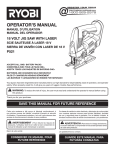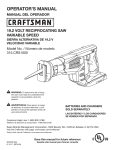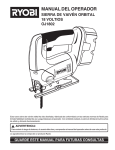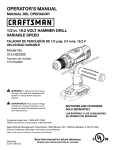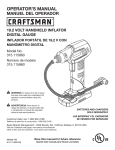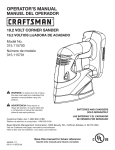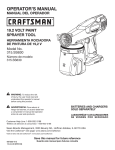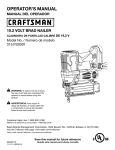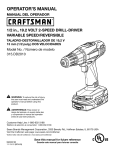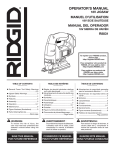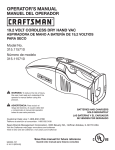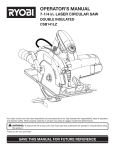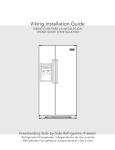Download Craftsman C3 Owner's Manual
Transcript
OPERATOR’S MANUAL MANUAL DEL OPERADOR 19.2 VOLT CORDLESS JIG SAW VARIABLE SPEED/ORBITAL SIERRA DE VAIVÉN INALÁMBRICA DE 19,2 V VELOCIDAD VARIABLE/ORBITAL Model No. 315.115690 Número de modelo 315.115690 WARNING: To reduce the risk of injury, the user must read and understand the operator’s manual before using this product. ADVERTENCIA: Para reducir el riesgo de lesiones, el usuario debe leer y comprender el manual del operador antes de usar este producto. BATTERIES AND CHARGERS SOLD SEPARATELY LAS BATTERÍAS Y LOS CARGADORES SE VENDEN POR SEPARADO Customer Help Line: 1-800-932-3188 Teléfono de atención al consumidor: 1-800-932-3188 Sears Brands Management Corporation, 3333 Beverly Rd., Hoffman Estates, IL 60179 USA Visit the Craftsman web page: www.sears.com/craftsman Visite el sitio web de Craftsman: www.sears.com/craftsman Save this manual for future reference 983000-920 8-31-10 (REV:04) Guarde este manual para futuras consulta TABLE OF CONTENTS / ÍNDICE DE CONTENIDO ESPAÑOL ENGLISH Warranty.......................................................................2 Introduction..................................................................2 Garantía.......................................................................2 Introducción.................................................................2 General Safety Rules............................................... 3-4 Reglas de seguridad generales............................... 3-4 Specific Safety Rules............................................... 4-5 Symbols.......................................................................6 Features.......................................................................7 Assembly.....................................................................8 Operation............................................................... 9-11 Adjustments...............................................................11 Maintenance..............................................................12 Accessories...............................................................12 Illustrated Parts List...................................................13 Figure numbers (illustrations).................................... i-iii Parts Ordering / Service.............................. Back Page Reglas de seguridad específicas............................. 4-5 Símbolos......................................................................6 Características.............................................................7 Armado........................................................................8 Funcionamiento..................................................... 9-11 Ajustes.......................................................................11 Mantenimiento...........................................................12 Accesorios.................................................................12 Figura numeras (ilustraciones).................................. i-iii Pedidos de piezas / Servicio.................. Pág. posterior WARRANTY / GARANTÍA CRAFTSMAN® ONE YEAR LIMITED WARRANTY FOR ONE YEAR from the date of purchase, this product is warranted against any defects in material or workmanship. With proof of purchase, defective product will be replaced free of charge. For warranty coverage details to obtain free replacement, visit the web site: www.craftsman.com This warranty does not cover the blades, which are expendable parts that can wear out from normal use within the warranty period. This warranty is void if this product is ever used while providing commercial services or if rented to another person. This warranty gives you specific legal rights, and you may also have other rights which vary from state to state. Sears Brands Management Corporation, Hoffman Estates, IL 60179 *** GARANTÍA LIMITADA DE CRAFTSMAN POR UN AÑO Este producto tiene garantía por cualquier defecto en material o mano de obra DURANTE UN AÑO desde la fecha de compra. Los productos defectuosos se remplazarán sin cargo si presenta un comprobante de pago. Si desea conocer los detalles de la cobertura de la garantía para conseguir reparaciones o recambios, visite el sitio Web: www.craftsman.com Esta garantía no cubre las hojas, que es una pieza fungible que puede desgastarse por el uso normal durante el período de garantía. La garantía pierde validez si este producto se utiliza mientras se prestan servicios comerciales o si se alquila a otra persona. Esta garantía le otorga derechos legales específicos y también puede gozar de otros derechos que varían según el estado. Sears Brands Management Corporation, Hoffman Estates, IL 60179 INTRODUCTION / INTRODUCCIÓN This tool has many features for making its use more pleasant and enjoyable. Safety, performance, and d ependability have been given top priority in the design of this product making it easy to maintain and operate. *** Esta herramienta ofrece numerosas características para hacer más agradable y placentero su uso. En el diseño de este producto se ha conferido prioridad a la seguridad, el desempeño y la fiabilidad, por lo cual se facilita su manejo y mantenimiento. 2 GENERAL SAFETY RULES WARNING! Read all instructions. Failure to follow all instructions listed below may result in electric shock, fire and/or serious injury. The term “power tool” in all of the warnings listed below refers to your mains-operated (corded) power tool or battery-operated (cordless) power tool. SAVE THESE INSTRUCTIONS WORK AREA SAFETY Keep work area clean and well lit. Cluttered or dark areas invite accidents. Do not operate power tools in explosive atmospheres, such as in the presence of flammable liquids, gases or dust. Power tools create sparks which may ignite the dust or fumes. Keep children and bystanders away while operating a power tool. Distractions can cause you to lose control. ELECTRICAL SAFETY Power tool plugs must match the outlet. Never modify the plug in any way. Do not use any adapter plugs with earthed (grounded) power tools. Unmodified plugs and matching outlets will reduce risk of electric shock. Avoid body contact with earthed or grounded surfaces such as pipes, radiators, ranges and refrigerators. There is an increased risk of electric shock if your body is earthed or grounded. Do not expose power tools to rain or wet conditions. Water entering a power tool will increase the risk of electric shock. Do not abuse the cord. Never use the cord for carrying, pulling or unplugging the power tool. Keep cord away from heat, oil, sharp edges or moving parts. Damaged or entangled cords increase the risk of electric shock. When operating a power tool outdoors, use an extension cord suitable for outdoor use. Use of a cord suitable for outdoor use reduces the risk of electric shock. Use battery only with charger listed. For use with 19.2V nickel-cadmium and 19.2V lithium-ion battery packs, see tool/appliance/battery pack/charger correlation supplement 988000-272. PERSONAL SAFETY Stay alert, watch what you are doing and use common sense when operating a power tool. Do not use a power tool while you are tired or under the influence of drugs, alcohol or medication. A moment of inattention while operating power tools may result in serious personal injury. Use safety equipment. Always wear eye protection. Safety equipment such as dust mask, non-skid safety shoes, hard hat, or hearing protection used for appropriate conditions will reduce personal injuries. Avoid accidental starting. Ensure the switch is in the off-position before plugging in. Carrying power tools with your finger on the switch or plugging in power tools that have the switch on invites accidents. Remove any adjusting key or wrench before turning the power tool on. A wrench or a key left attached to a rotating part of the power tool may result in personal injury. Do not overreach. Keep proper footing and balance at all times. This enables better control of the power tool in unexpected situations. Dress properly. Do not wear loose clothing or jewelry. Keep your hair, clothing and gloves away from moving parts. Loose clothes, jewelry, or long hair can be caught in moving parts. If devices are provided for the connection of dust extraction and collection facilities, ensure these are connected and properly used. Use of these devices can reduce dust-related hazards. Do not wear loose clothing or jewelry. Contain long hair. Loose clothes, jewelry, or long hair can be drawn into air vents. Do not use on a ladder or unstable support. Stable footing on a solid surface enables better control of the power tool in unexpected situations. POWER TOOL USE AND CARE Do not force the power tool. Use the correct power tool for your application. The correct power tool will do the job better and safer at the rate for which it was designed. Do not use the power tool if the switch does not turn it on and off. Any power tool that cannot be controlled with the switch is dangerous and must be repaired. Disconnect the plug from the power source and/or the battery pack from the power tool before making any adjustments, changing accessories, or storing power tools. Such preventive safety measures reduce the risk of starting the power tool accidentally. Store idle power tools out of the reach of children and do not allow persons unfamiliar with the power tool or these instructions to operate the power tool. Power tools are dangerous in the hands of untrained users. Maintain power tools. Check for misalignment or binding of moving parts, breakage of parts, and any other condition that may affect the power tool’s operation. If damaged, have the power tool repaired before use. Many accidents are caused by poorly maintained power tools. 3 – English GENERAL SAFETY RULES Keep cutting tools sharp and clean. Properly maintained cutting tools with sharp cutting edges are less likely to bind and are easier to control. Use the power tool, accessories and tool bits etc., in accordance with these instructions and in the manner intended for the particular type of power tool, taking into account the working conditions and the work to be performed. Use of the power tool for operations different from those intended could result in a hazardous situation. nails, screws, or other small metal objects that can make a connection from one terminal to another. Shorting the battery terminals together may cause burns or a fire. Under abusive conditions, liquid may be ejected from the battery, avoid contact. If contact accidentally occurs, flush with water. If liquid contacts eyes, additionally seek medical help. Liquid ejected from the battery may cause irritation or burns. BATTERY TOOL USE AND CARE Have your power tool serviced by a qualified repair person using only identical replacement parts. This will ensure that the safety of the power tool is maintained. Ensure the switch is in the off position before inserting battery pack. Inserting the battery pack into power tools that have the switch on invites accidents. Recharge only with the charger specified by the manufacturer. A charger that is suitable for one type of battery pack may create a risk of fire when used with another battery pack. Use power tools only with specifically designated battery packs. Use of any other battery packs may create a risk of injury and fire. When battery pack is not in use, keep it away from other metal objects like paper clips, coins, keys, SERVICE WARNING! To reduce the risk of injury, user must read instruction manual. When servicing a power tool, use only identical replacement parts. Follow instructions in the Maintenance section of this manual. Use of unauthorized parts or failure to follow Maintenance instructions may create a risk of shock or injury. SPECIFIC SAFETY RULES Hold tool by insulated gripping surfaces when performing an operation where the cutting tool may contact hidden wiring or its own cord. Contact with a “live” wire will also make exposed metal parts of the tool “live” and shock the operator. Know your power tool. Read operator’s manual carefully. Learn its applications and limitations, as well as the specific potential hazards related to this tool. Following this rule will reduce the risk of electric shock, fire, or serious injury. Always wear safety glasses with side shields. Everyday glasses have only impact resistant lenses. They are NOT safety glasses. Following this rule will reduce the risk of eye injury. Protect your lungs. Wear a face or dust mask if the operation is dusty. Following this rule will reduce the risk of serious personal injury. Protect your hearing. Wear hearing protection during extended periods of operation. Following this rule will reduce the risk of serious personal injury. Battery tools do not have to be plugged into an electrical outlet; therefore, they are always in operating condition. Be aware of possible hazards when not using your battery tool or when changing accessories. Following this rule will reduce the risk of electric shock, fire, or serious personal injury. Do not place battery tools or their batteries near fire or heat. This will reduce the risk of explosion and possibly injury. Never use a battery that has been dropped or received a sharp blow. A damaged battery is subject to explosion. Properly dispose of a dropped or damaged battery immediately. Do not crush, drop or damage battery pack. Do not use a battery pack or charger that has been dropped or received a sharp blow. A damaged battery is subject to explosion. Properly dispose of a dropped or damaged battery immediately. Batteries can explode in the presence of a source of ignition, such as a pilot light. To reduce the risk of serious personal injury, never use any cordless product in the presence of open flame. An exploded battery can propel debris and chemicals. If exposed, flush with water immediately. Do not charge battery tool in a damp or wet location. Following this rule will reduce the risk of electric shock. For best results, your battery tool should be charged in a location where the temperature is more than 50°F but less than 100°F. Do not store outside or in vehicles. 4 – English SPECIFIC SAFETY RULES Under extreme usage or temperature conditions, battery leakage may occur. If liquid comes in contact with your skin, wash immediately with soap and water. If liquid gets into your eyes, flush them with clean water for at least 10 minutes, then seek immediate medical attention. Following this rule will reduce the risk of serious personal injury. LASER GUIDE WARNINGS: The laser guide radiation used in this tool is Class IIIa with maximum <5 mW and 650nm wavelengths. These lasers do not normally present an optical hazard although staring at the beam may cause flash blindness. Avoid direct eye exposure when using the laser guide. The laser shall be used and maintained in accordance with the manufacturer’s instructions. Never aim the beam at a person or object other than the workpiece. Always ensure the laser beam is aimed at a sturdy workpiece without reflective surfaces. Shiny reflective sheet metal or similar shiny materials are not suitable for laser use. All repairs should be made by an authorized service representative or the laser manufacturer. Save these instructions. Refer to them frequently and use them to instruct others who may use this power tool. If you loan someone this power tool, loan them these instructions also. WARNING: Some dust created by power sanding, sawing, grinding, drilling, and other construction activities contains chemicals known to cause cancer, birth defects or other reproductive harm. Some examples of these chemicals are: • lead from lead-based paints, • crystalline silica from bricks and cement and other masonry products, and • arsenic and chromium from chemically-treated lumber. Your risk from these exposures varies, depending on how often you do this type of work. To reduce your exposure to these chemicals: work in a well ventilated area, and work with approved safety equipment, such as those dust masks that are specially designed to filter out microscopic particles. 5 – English SYMBOLS The following signal words and meanings are intended to explain the levels of risk associated with this product. SYMBOL SIGNAL MEANING DANGER: Indicates an imminently hazardous situation, which, if not avoided, will result in death or serious injury. WARNING: Indicates a potentially hazardous situation, which, if not avoided, could result in death or serious injury. CAUTION: Indicates a potentially hazardous situation, which, if not avoided, may result in minor or moderate injury. CAUTION: (Without Safety Alert Symbol) Indicates a situation that may result in property damage. Some of the following symbols may be used on this product. Please study them and learn their meaning. Proper interpretation of these symbols will allow you to operate the product better and safer. SYMBOL Li - Ion V min no .../min NAME DESIGNATION/EXPLANATION Safety Alert Indicates a potential personal injury hazard. Read Operator’s Manual To reduce the risk of injury, user must read and understand operator’s manual before using this product. Eye Protection Always wear eye protection with side shields marked to comply with ANSI Z87.1. No Hands Symbol Failure to keep your hands away from the blade will result in serious personal injury. Wet Conditions Alert Do not expose to rain or use in damp locations. Recycle Symbols This product uses nickel-cadmium (Ni-Cd) and lithium-ion (Li-ion) batteries. Local, state or federal laws may prohibit disposal of batteries in ordinary trash. Consult your local waste authority for information r egarding available recycling and/or disposal options. Volts Voltage Minutes Time Direct Current Type or a characteristic of current No Load Speed Rotational speed, at no load Per Minute Revolutions, strokes, surface speed, orbits etc., per minute 6 – English FEATURES PRODUCT SPECIFICATIONS Length of Stroke............................................................ 1 in. Strokes Per Minute.......................................... 0-2,100/min. Switch...........................................................Variable Speed Blade Clamp............................................................Toolless Cutting Angle................................. 0° to 45°, Left and Right Orbital Motion..................................................... 4 Positions Laser Guide..........................Class IIIa, <5mW max, 650nm KNOW YOUR JIG SAW LOCK-OFF BUTTON See Figure 1, page i. Your saw is equipped with a lock-off button which reduces the possibility of accidental starting. The safe use of this product requires an understanding of the information on the tool and in this operator’s manual as well as a knowledge of the project you are attempting. Before use of this product, familiarize yourself with all operating features and safety rules. ORBITAL ADJUSTMENT KNOB Choose from four orbital adjustment positions for fine to aggressive cutting. BLADE STORAGE TOOLLESS BLADE CLAMP When not in use, you can place the blades provided with your orbital jig saw in the storage area located on the back of the saw. Your saw has a blade clamp design that does not require the use of a tool (blade wrench) when installing or removing the blade. ERGONOMIC DESIGN VARIABLE SPEED The design of the orbital jig saw provides for easy handling. It is designed for comfort when operating in different positions and at different angles. This tool has a variable speed switch that delivers higher speed with increased trigger pressure. LASER GUIDE The laser guide will generate a red colored laser beam on the work surface in front of the saw when turned on. 7 – English ASSEMBLY UNPACKING WARNING: If any parts are damaged or missing This product has been shipped completely assembled. do not operate this tool until the parts are replaced. Use of this product with damaged or missing parts could result in serious personal injury. n Carefully remove the tool and any accessories from the box. Make sure that all items listed in the packing list are included. WARNING: Do not attempt to modify this tool WARNING: Do not use this product if it is not completely assembled or if any parts appear to be missing or damaged. Use of a product that is not properly and completely assembled could result in serious personal injury. n Inspect the tool carefully to make sure no breakage or damage occurred during shipping. n Do not discard the packing material until you have carefully inspected and satisfactorily operated the tool. n If any parts are damaged or missing, please call 1-800-932-3188 for assistance. PACKING LIST Orbital Jig Saw Blade Hex Key Operator’s Manual 8 – English or create accessories not recommended for use with this tool. Any such alteration or modification is misuse and could result in a hazardous condition leading to possible serious personal injury. WARNING: To prevent accidental starting that could cause serious personal injury, always remove the battery pack from the tool when assembling parts. OPERATION WARNING: Do not allow familiarity with tools to make you careless. Remember that a careless fraction of a second is sufficient to inflict serious injury. WARNING: Always wear eye protection with side shields marked to comply with ANSI Z87.1. Failure to do so could result in objects being thrown into your eyes, resulting in possible serious injury. WARNING: Do not use any attachments or accessories not recommended by the manufacturer of this product. The use of attachments or accessories not recommended can result in serious personal injury. APPLICATIONS You may use this tool for the following purposes: Sawing non-ferrous metal, sheet steel, wood, plastic, and similar materials Cutting wood surfaces Cutting thin sheet metal Cutting plastics and laminates This product will accept Craftsman 19.2 V lithium-ion battery packs and Craftsman 19.2 V nickel-cadmium battery packs. For complete charging instructions, refer to the Operator’s Manual for your battery pack and charger models. BATTERY PROTECTION FEATURES Craftsman 19.2 V lithium-ion battery packs are designed with features that protect the lithium-ion cells and maximize battery life. If the tool stops during use, release the trigger to reset and resume operation. If the tool still does not work, the battery needs to be recharged. TO INSTALL BATTERY PACK See Figure 2, page i. Lock the switch trigger by placing the rotation selector in the center position. Place the battery pack on the tool. Make sure the latches on each side of the battery pack snap into place and the battery pack is secured on the tool before beginning operation. WARNING: Always remove battery pack from your tool when you are assembling parts, making adjustments, cleaning, or when not in use. Removing battery pack will prevent accidental starting that could cause serious personal injury. TO REMOVE BATTERY PACK See Figure 2, page i. Lock the switch trigger by placing the rotation selector in the center position. Depress the latches on the side of battery pack. Remove the battery pack from the tool. WARNING: To prevent accidental starting that could cause serious personal injury, always remove the battery pack from the tool when assembling parts. TO INSTALL BLADES See Figure 3, page i. Remove battery pack. Lift blade clamp lock/release lever located on front of saw. Insert saw blade between blade clamp and saw bar as far as possible. Release and lock blade clamp lever. Replace battery pack. BLADE SELECTION To obtain the best performance from the saw, it is important to select a specific blade for the particular application and type of material you wish to cut. By doing this you will get a smoother, faster cut and prolong blade life. Replacement blades for this saw are available from your nearest Sears retail. It is recommended you use a T-shank blade. If a T-shank blade is not available, a high quality U-shank may be used. BLADE STORAGE See Figure 4, page i. A convenient feature on the saw is the blade storage compartment. The blade storage compartment is located on the back of the saw. It is convenient for storing extra blades and storing blades when not in use. To open: Push the door down with your thumb or finger. Place blades in blade storage compartment. To close: Push the door up with your thumb or finger. HEX KEY STORAGE See Figure 5, page ii. Secure hex key on the saw base behind the rubber CAUTION: When placing the battery pack in the covered tab. Push into place. tool, be sure raised rib on battery pack aligns with the groove in the tool and that the latches snap into Make sure the hex key is secured before performing place properly. Improper assembly of the battery any sawing operation. pack can cause damage to internal components. Remove by pulling on the hex key. 9 – English OPERATION LASER GUIDE SCROLL CUTTING See Figure 6, page ii. Depress the laser guide switch to generate a red laser beam on the work surface in front of the saw. Use the laser to guide the saw along the line of cut. See Figure 8, page ii. Scroll cuts can be made with the jig saw by guiding the direction of the cut with applied pressure on the handle. LOCK-OFF BUTTON See Figures 9 - 10, page ii. Bevel cutting angles may be adjusted from 0° to 45° right or left. Angles for cuts from 0° to 45° in 15° increments are marked on a scale on both the left and right side of the base. Notches on the rear of the base provide positive stops at each of the above mentioned 15° increments. A protractor is recommended when accurate cuts are required. See Figure 7, page ii. The lock-off button is located on the handle above the switch trigger. You must depress the lock-off button in order to pull the switch trigger. The lock resets each time the trigger is released. NOTE: You can depress the lock-off button from either the left or right side. SWITCH TRIGGER See Figure 7, page ii. To turn the saw ON, depress and hold lock-off button, then depress the switch trigger. To turn it OFF, release the switch trigger. GENERAL CUTTING See Figure 7, page ii. Rest the front of the saw base on the workpiece and align cutting edge of the blade with the line on your workpiece. Start the saw and move it forward on the work surface. Apply downward pressure to keep the saw steady and only enough forward pressure to keep the blade cutting. Do not force the saw. Forcing the saw may overheat the motor and break saw blades. Broken saw blades must be discarded. Remove the broken portion of the saw blade from the clamp and install a new saw blade. WARNING: Excessive side pressure on the blade could result in broken blades or damage to the material being cut. ORBITAL MOTION ANGLE CUTTING (BEVEL CUTTING) Remove the battery pack. Using the 1/8 in. hex key provided, loosen the base pivot screws until the base can be moved. Slide base forward until base pivot screws can move freely in slots in base. Align the mark, on the base, of the desired angle with the edge of the motor housing. Once the desired angle is reached, slide base back until tab on motor housing aligns with the appropriate notch on rear of base. NOTE: When making a set-up for accurate cuts with a protractor, or for angles other than the preset 15° increments, the positive stop notches on the rear of the base are not used. Tighten the base pivot screws securely. Return hex key to storage compartment. Replace the battery pack. NOTE: The wide slot in the base must be used when making bevel cuts, scroll cuts, plunge cuts, and when cutting metal. PLUNGE CUTTING See Figures 11 - 12, page ii. WARNING: To avoid loss of control, broken blades, or damage to the material being cut, always use extreme caution when making plunge cuts. We do not recommend plunge cutting on materials other than wood. See Figure 7, page ii. The blade of the saw cuts in orbital motion. This feature is adjustable and provides faster, more efficient cutting. The blade cuts through your work in the upstroke but does not drag across your work in the downstroke. The higher settings should be used when fast cutting in soft material is desired. The lower settings should be used when cutting materials with more resistance. TO MAKE A PLUNGE CUT STRAIGHT CUT Drill a pilot hole though any point on the line of cut. Mark the line of cut clearly on the workpiece. Set the cutting angle at 0° and the orbital adjustment knob to 0. See Figure 7, page ii. Using high speed, start the saw and slowly lower the blade through the pilot hole into the workpiece until the A straight cut can be made by clamping a piece of wood blade cuts through the wood. or straightedge to the workpiece and guiding the edge of the saw against it. Make the cut from one direction only. Do not move the base forward until the blade cuts Do not cut halfway and complete the cut from the oppoentirely through the workpiece and the base is in site end. complete contact with the workpiece. 10 – English OPERATION Move the saw forward to complete the opening. Use only the seven teeth per inch blade for this type of cut. NOTE: When setting angle at 0° for splinter-free cutting, the positive stop notches on the rear of the base are not used. Tighten base pivot screws securely. SPLINTER-FREE CUTTING See Figures 13 - 14, page iii. The base of the jig saw has a narrow slot to permit splinter-free cutting. It is especially useful when cutting plywood. This feature should only be used when making straight cuts or circle cuts. It is not for bevel cutting or plunge cutting. NOTE: The non-orbital setting also helps reduce splintering when cutting plywood. POSITIONING BASE IN THE SPLINTER-FREE CUTTING POSITION Remove the battery pack. Using the 1/8 in. hex key provided, loosen base pivot screws and slide base forward. Remove hex key and return it to storage compartment. Replace the battery pack. OPTIONAL EDGE GUIDE See Figure 15, page iii. An optional edge guide is available for use with the saw. It can be used for making cross cuts and rip cuts. Remove the battery pack. Loosen the edge guide screw. Insert the arm through the two slots in the base of the saw as shown. Adjust the edge guide to the desired width and lock in place with the edge guide screw. Replace the battery pack. Always set the cutting angle at 0° for splinter-free cutting. To set cutting angle at 0°, align the 0° mark on the scale with the edge of the motor housing. ADJUSTMENTS WARNING: Use of controls or adjustments or performance of procedures other than those specified herein could result in hazardous radiation exposure. ADJUSTING THE LASER See Figure 16, page iii. The laser can be realigned by adjusting the two screws located in the front of the saw. The top screw moves the laser beam laterally from left to right. The bottom screw moves the laser beam in a rotational direction. NOTE: Draw a pencil line on scrap workpiece parallel to the long edge of the base as a straight line guide to aid in the adjusting process. Turn laser on. Rest base of saw on scrap workpiece. Adjust screws as necessary. Since blade thicknesses vary, always make a trial cut in scrap workpiece to ensure an accurate cut. Check for proper alignment. Repeat as necessary until laser is aligned. 11 – English MAINTENANCE WARNING: Do not at any time let brake fluids, WARNING: When servicing, use only identical gasoline, petroleum-based products, penetrating oils, etc., come in contact with plastic parts. Chemicals can damage, weaken or destroy plastic which may result in serious personal injury. Craftsman replacement parts. Use of any other part may create a hazard or cause product damage. WARNING: Always wear eye protection with side shields marked to comply with ANSI Z87.1. Failure to do so could result in objects being thrown into your eyes, resulting in possible serious injury. Only the parts shown on the parts list are intended to be repaired or replaced by the customer. All other parts should be replaced at a Sears Service Center. WARNING: To avoid serious personal injury, always BATTERY PACK REMOVAL AND PREPARATION FOR RECYCLING remove the battery pack from the tool when cleaning or performing any maintenance. WARNING: Upon removal, cover the battery pack’s terminals with heavy-duty adhesive tape. Do not attempt to destroy or disassemble battery pack or remove any of its components. Lithium-ion and nickel-cadmium batteries must be recycled or disposed of properly. Also, never touch both terminals with metal objects and/or body parts as short circuit may result. Keep away from children. Failure to comply with these warnings could result in fire and/ or serious injury. GENERAL MAINTENANCE Avoid using solvents when cleaning plastic parts. Most plastics are susceptible to damage from various types of commercial solvents and may be damaged by their use. Use clean cloths to remove dirt, dust, oil, grease, etc. ACCESSORIES Look for these accessories at Sears retail: Edge Guide...............................................................................................................................................Item No. 926320 WARNING: Current attachments and accessories available for use with this tool are listed above. Do not use any attachments or accessories not recommended by the manufacturer of this tool. The use of attachments or accessories not recommended can result in serious personal injury. 12 CRAFTSMAN 19.2 VOLT CORDLESS JIG SAW – MODEL NO. 315.115690 The model number will be found on a label attached to the motor housing. Always mention the model number in all correspondence regarding your CORDLESS JIG SAW or when ordering repair parts. SEE BACK PAGE FOR PARTS ORDERING INSTRUCTIONS 9 ® 4 8 10 7 6 5 1 3 2 PARTS LIST Key Part No. Number Description Qty. 1 *** Wood Cutting Blade......................... 1 *** Metal Cutting Blade (not shown)...... 1 2 660302002*Screw (#10-24 x 1/2 in.)................... 2 3630847003 Plate................................................. 1 4 660302001*Screw (#10-24 x 3/8 in.)................... 1 5630846012 Base................................................. 1 6 680907001*Hex Key (3 mm)................................ 1 Key Part No. Number Description Qty. 7 550432001 Rubber Tube..................................... 1 8671314002 Blade Guard..................................... 1 9 940077089 Data Label........................................ 1 10 940054131 Logo Label........................................ 1 11 681070001 *Hex Key (5/64 mm - Not Shown)...... 1 12 606551003 Edge Guide (Optional - Not Shown) 983000920 Operator’s Manual (Not Shown) * Standard Hardware Item – May Be Purchased Locally *** Complete assortment available at your Nearest Sears Retail Store 13 Fig. 1 A Fig. 2 B A B C E ® D A -Depress latches to release battery pack (para soltar el paquete de baterías oprima los pestillos) B-To install (para la instalación) C-To remove (para el desmontaje) D-Battery pack (paquete de baterías) E-Latches (pestillos) Fig. 3 C F E Fig. 3 A D I B D G C A -Lift blade clamp (levante la mordaza de la cuchilla) B-Blade clamp lock/release lever (palanca de aseguramiento y afloje de la mordaza de la cuchilla) C-Saw blade (hoja de la sierra) D-Blade clamp (mordaza de la cuchilla) H Fig. 4 A -Lock-off button (botón del seguro de apagado) B-Switch trigger (gatillo del interruptor) C-Toolless blade clamp (mordaza de la cuchilla de apriete sin herramienta) D-Saw blade (hoja de la sierra) E-Orbital adjustment knob (perilla de ajuste de órbita) F-Saw base (base de la sierra) G-Hex key (llave hexagonal) H-Hex key storage (lugar de guardar la llave hexagonal) I -Laser guide switch (interruptor de guía láser) A B A -Saw blade (hoja de la sierra) B-Blade storage compartment (compartimiento de las hojas) i Fig. 5 Fig. 7 Fig. 9 A A B A C B B A -Hex key (llave hexagonal) B-Hex key storage area (lugar de guardar la llave hexagonal) C A-Base pivot screws (tornillos del pivote de la base) B-Saw base (base de la sierra) C-Hex key (llave hexagonal) ® Fig. 6 PELIGRO Radiación láser – Evite la exposición directa de los ojos. F Salida máx. <5 mW Longitud de onda: 650nm Fig. 10 Aparato láser Clase IIIa A B ® A -Switch trigger (gatillo del interruptor) B-Lock-off button (botón del seguro de apagado) C-Laser guide (guía láser) D-To increase orbital setting (para aumentar el ajuste de la órbita) E-To decrease orbital setting (para disminuir el ajuste de la órbita) F-Orbital adjustment knob (perilla de ajuste de órbita) Fig. 8 B 45 30 15 0 RYLD E D A A-Scale (indicador de la escala) B-Saw base (base de la sierra) ® Cumple con la norma 21 CFR, partes 1040.10 y 1040.11 Fig. 11 PELIGRO Radiación láser al estar abierto, evite la exposición directa de los ojos. A EVITE EXPONERSE Hay radiación láser a través de esta abertura. A-Pilot hole (agujero guía) Fig. 12 A -Laser guide switch (interruptor de guía láser) B-Laser guide (guía láser) A A-Pilot hole (agujero guía) ii Fig. 13 Fig. 15 A Fig. 16 A D B ® C A-Pilot screws (tornillos del pivote de la base) B-Saw base (base de la sierra) C-Hex key (llave hexagonal) D-Narrow slot used for splinter-free cutting (ranura angosta empleada para efectuar cortes sin astillas) Fig. 14 B C D B A-Edge guide screw (tornillo de la guía para cantos) B-Slot (ranura) C-Edge guide (guía para cantos) D-Saw base (base de la sierra) A A-Set scale at 0° for splinter-free cutting (ponga la escala a 0°, para efectuar cortes sin astillas) iii A A-Moves the laser beam laterally left to right (sirve para mover el rayo láser de izquierda a derecha) B-Moves the laser beam in a rotational direction (sirve para mover el rayo láser en una dirección rotatoria) REGLAS DE SEGURIDAD GENERALES SEGURIDAD PERSONAL ¡ADVERTENCIA! Lea todas las instrucciones. El incumplimiento de las instrucciones señaladas abajo puede causar descargas eléctricas, incendios y lesiones serias. El término “herramienta eléctrica” empleado en todos los avisos de advertencia enumerados abajo se refiere a las herramientas eléctricas de cordón (alámbricas) y de baterías (inalámbricas). GUARDE ESTAS INSTRUCCIONES SEGURIDAD EN EL ÁREA DE TRABAJO Mantenga limpia y bien iluminada el área de trabajo. Un área de trabajo mal despejada o mal iluminada propicia accidentes. No utilice herramientas motorizadas en atmósferas explosivas, como las existentes alrededor de líquidos, gases y polvos inflamables. Las herramientas eléctricas generan chispas que pueden encender el polvo y los vapores inflamables. Mantenga alejados a los niños y circunstantes al maniobrar una herramienta eléctrica. Toda distracción puede causar la pérdida del control de la herramienta. SEGURIDAD ELÉCTRICA Las clavijas de las herramientas eléctricas deben corresponder a las tomas de corriente donde se conectan. Nunca modifique la clavija de ninguna forma. No utilice ninguna clavija adaptadora con herramientas eléctricas dotadas de contacto a tierra. Conectando las clavijas originales en las tomas de corriente donde corresponden se disminuye el riesgo de una descarga eléctrica. Evite el contacto del cuerpo con las superficies de objetos que estén haciendo tierra o estén conectados a ésta, como las tuberías, radiadores, estufas y refrigeradores. Existe un mayor riesgo de descargas eléctricas si el cuerpo está haciendo tierra. No exponga las herramientas eléctricas a la lluvia ni a condiciones de humedad. La introducción de agua en una herramienta eléctrica aumenta el riesgo de descargas eléctricas. No maltrate el cordón eléctrico. Nunca utilice el cordón para trasladar, desconectar o tirar de la herramienta eléctrica. Mantenga el cordón alejado del calor, del aceite, de bordes afilados y de piezas móviles. Los cordones eléctricos dañados o enredados aumentan el riesgo de descargas eléctricas. Al utilizar una herramienta eléctrica a la intemperie, use un cordón de extensión apropiado para el exterior. Usando un cordón adecuado para el exterior se disminuye el riesgo de descargas eléctricas. Cargue las baterías solamente con el cargador indicado. Para utilizar con paquetes de baterías de níquel-cadmio de 19,2 V o de iones de litio de 19,2 V, consulte el folleto de la herramienta/aparato/paquete de baterías/cargador complementario 988000-272. Permanezca alerta, preste atención a lo que esté haciendo y aplique el sentido común al utilizar herramientas eléctricas. No utilice la herramienta eléctrica si está cansado o se encuentra bajo los efectos de alguna droga, alcohol o medicamento. Un momento de inatención al utilizar una herramienta eléctrica puede causar lesiones corporales serias. Use equipo de seguridad. Siempre póngase protección ocular. El uso de equipo de seguridad como mascarilla para el polvo, calzado de seguridad, casco y protección para los oídos en las circunstancias donde corresponda disminuye el riesgo de lesiones. Evite un arranque accidental de la unidad. Asegúrese de que el interruptor esté en la posición de apagado antes de conectar la herramienta. Portar las herramientas eléctricas con el dedo en el interruptor, o conectarlas con el interruptor puesto, propicia accidentes. Retire toda llave o herramienta de ajuste antes de encender la herramienta eléctrica. Toda llave o herramienta de ajuste dejada en una pieza giratoria de la herramienta eléctrica puede causar lesiones. No estire el cuerpo para alcanzar mayor distancia. Mantenga una postura firme y buen equilibrio en todo momento. De esta manera se logra un mejor control de la herramienta eléctrica en situaciones inesperadas. Vístase adecuadamente. No vista ropas holgadas ni joyas. Mantenga el cabello, la ropa y los guantes alejados de las piezas móviles. Las ropas holgadas, las joyas y el cabello largo pueden engancharse en las piezas móviles. Si se suministran dispositivos para conectar mangueras de extracción y captación de polvo, asegúrese de que éstas estén bien conectadas y se usen correctamente. La utilización de estos dispositivos puede disminuir los peligros relacionados con el polvo. No vista ropas holgadas ni joyas. Recójase el cabello si está largo. Las ropas holgadas y las joyas, así como el cabello largo, pueden resultar atraídas hacia el interior de las aberturas de ventilación. No utilice la unidad al estar en una escalera o en un soporte inestable. Una postura estable sobre una superficie sólida permite un mejor control de la herramienta eléctrica en situaciones inesperadas. EMPLEO Y CUIDADO DE LA HERRAMIENTA ELÉCTRICA No fuerce la herramienta eléctrica. Utilice la herramienta eléctrica adecuada para cada trabajo. La herramienta eléctrica adecuada efectúa mejor y de manera más segura el trabajo, si además se maneja a la velocidad para la que está diseñada. No use la herramienta eléctrica si el interruptor no enciende o no apaga. Cualquier herramienta eléctrica que no pueda controlarse con el interruptor es peligrosa y debe repararse. 3 – Español REGLAS DE SEGURIDAD GENERALES Desconecte la clavija del suministro de corriente o retire el paquete de baterías de la herramienta eléctrica, según sea el caso, antes de efectuarle cualquier ajuste, cambiarle accesorios o guardarla. Tales medidas preventivas de seguridad reducen el riesgo de poner en marcha accidentalmente la herramienta. Guarde las herramientas eléctricas desocupadas fuera del alcance de los niños y no permita que las utilicen personas no familiarizadas con las mismas o con estas instrucciones. Las herramientas eléctricas son peligrosas en manos de personas no capacitadas en el uso de las mismas. Preste servicio a las herramientas eléctricas. Revise para ver si hay desalineación o atoramiento de piezas móviles, ruptura de piezas o toda otra condición que pueda afectar el funcionamiento de la herramienta. Si está dañada la herramienta eléctrica, llévela a reparar antes de usarla. Numerosos accidentes son causados por herramientas eléctricas mal cuidadas. Mantenga las herramientas de corte afiladas y limpias. Las herramientas de corte bien cuidadas y con bordes bien afilados, tienen menos probabilidad de atascarse en la pieza de trabajo y son más fáciles de controlar. Utilice la herramienta eléctrica, los accesorios y brocas, hojas de corte, ruedas de esmeril, etc. de conformidad con estas instrucciones, y de la forma apropiada para cada una de dichas herramientas, tomando en cuenta las condiciones de trabajo y la tarea por realizar. Si se utiliza la herramienta eléctrica para operaciones diferentes de las indicadas podría originar una situación peligrosa. EMPLEO Y CUIDADO DE LA HERRAMIENTA DE BATERÍAS Asegúrese de que el interruptor esté en la posición de apagado antes de introducir el paquete de baterías. Introducir el paquete de baterías en una herramienta eléctrica que tenga el interruptor en encendido propicia accidentes. Sólo cargue el paquete de baterías con el cargador especificado por el fabricante. Un cargador adecuado para un tipo paquete de baterías puede significar un riesgo de incendio si se emplea con un paquete de baterías diferente. Utilice las herramientas eléctricas sólo con los paquetes de baterías específicamente indicados. El empleo de paquetes de baterías diferentes puede presentar un riesgo de incendio. Cuando no esté utilizándose el paquete de baterías, manténgalo lejos de otros objetos metálicos como clips, monedas, llaves, clavos, tornillos y otros objetos metálicos pequeños que puedan establecer conexión entre ambas terminales. Establecer una conexión directa entre las dos terminales de las baterías puede causar quemaduras o incendios. Si se maltratan las baterías, puede derramarse líquido de las mismas; evite todo contacto con éste. En caso de contacto, lávese con agua. Si el líquido llega a tocar los ojos, además busque atención médica. El líquido de las baterías puede causar irritación y quemaduras. SERVICIO Permita que un técnico de reparación calificado preste servicio a la herramienta eléctrica, y sólo con piezas de repuesto idénticas. De esta manera se mantiene la seguridad de la herramienta eléctrica. ¡ADVERTENCIA! Para reducir el riesgo de lesiones, el usuario debe leer el manual de instrucciones. Al dar servicio a una herramienta eléctrica, sólo utilice piezas de repuesto idénticas. Siga las instrucciones señaladas en la sección Mantenimiento de este manual. El empleo de piezas no autorizadas o el incumplimiento de las instrucciones de mantenimiento puede significar un riesgo de descarga eléctrica o de lesiones. REGLAS DE SEGURIDAD ESPECÍFICAS Sujete las herramientas eléctricas por las superficies aisladas de sujeción al efectuar una operación en la cual la herramienta de corte pueda entrar en contacto con cables ocultos o con su propio cordón eléctrico. Todo contacto de una herramienta con un cable cargado carga las piezas metálicas expuestas de la herramienta y da una descarga eléctrica al operador. Familiarícese con su herramienta eléctrica. Lea cuidadosamente el manual del operador. Aprenda sus usos y limitaciones, así como los posibles peligros específicos de esta herramienta. Al cumplir esta regla se reduce el riesgo de descargas eléctricas, incendios o lesiones graves. 4 – Español REGLAS DE SEGURIDAD ESPECÍFICAS Siempre use gafas de seguridad con guardas laterales. Los cristales de los anteojos comunes resisten sólo impactos menores. NO son anteojos de seguridad. Al cumplir esta regla se reduce el riesgo de posibles lesiones oculares. Protéjase los pulmones. Use una careta o mascarilla contra el polvo si la operación lo genera en gran cantidad. Al cumplir esta regla se reduce el riesgo de lesiones graves. Protéjase los oídos. Durante períodos prolongados de uso del producto, póngase protección para los oídos. Al cumplir esta regla se reduce el riesgo de lesiones corporales graves. Las herramientas de baterías no requieren conectarse a una toma de corriente; por tanto, siempre están en condiciones de funcionamiento. Tenga presentes los posibles peligros cuando no esté usando la herramienta de baterías o cuando esté cambiando sus accesorios. Al cumplir esta regla se reduce el riesgo de descargas eléctricas, incendios o lesiones graves. No coloque herramientas de baterías ni las baterías mismas cerca del fuego o del calor. De esta manera se reduce el riesgo de explosiones y lesiones. Nunca vuelva a utilizar una batería que haya sufrido una caída o un golpe sólido. Las baterías dañadas pueden explotar. Deseche de inmediato toda batería que haya sufrido una caída o cualquier daño. No aplaste, deje caer o dañe la batería. Nunca utilice una batería o cargador que se ha caído, aplastado, recibido un golpe contundente o ha sido dañado(a) de alguna manera. Las baterías dañadas pueden sufrir explosiones. Deseche de inmediato toda batería que haya sufrido una caída o cualquier daño. Las baterías pueden explotar en presencia de una fuente de inflamación, como una luz indicadora (piloto). Para reducir el riesgo de lesiones graves, nunca use un producto inalámbrico en presencia de llamas expuestas. La explosión de una batería puede lanzar fragmentos y compuestos químicos. Si llegara a tener este accidente, lávese con agua de inmediato. No cargue la herramienta de baterías en un lugar mojado o húmedo. Al cumplir esta regla se reduce el riesgo de una descarga eléctrica. Para obtener resultados óptimos, debe cargar la herramienta de baterías en un lugar donde la temperatura esté entre 10 y 38°C (entre 50 y 100°F). No guarde la herramienta a la intemperie ni en el interior de vehículos. En condiciones extremas de uso o de temperatura, las baterías pueden emanar líquido. Si el líquido llega a tocarle la piel, lávese de inmediato con agua y jabón. Si le entra líquido en los ojos, láveselos con agua limpia por lo menos 10 minutos, y después busque de inmediato atención médica. Al cumplir esta regla se reduce el riesgo de lesiones graves. ADVERTENCIAS SOBRE LA GUÍA DE LÁSER: La radiación de la guía de láser de esta herramienta es de Clase IIIa, con potencia máxima <5 mW y longitud de onda de 650 nm. En el uso normal este tipo de láser no afecta la vista, pero si ésta se mantiene fija en el haz puede producirse ceguera por encandilamiento. Evite la exposición directa de los ojos al emplear la guía de láser. El uso y el mantenimiento del láser deben hacerse conforme a las instrucciones del fabricante. Nunca apunte el haz hacia una persona u objeto que no sea la pieza de trabajo. Verifique siempre que el objeto al que dirigirá el haz del láser sea resistente y no tenga superficies reflejantes. Las láminas metálicas o materiales lustrosos semejantes no se prestan al uso del láser. Toda reparación deberá ser realizada por un representante técnico autorizado o por el fabricante del láser. Guarde estas instrucciones. Consúltelas con frecuencia y empléelas para instruir a otras personas que puedan utilizar esta herramienta. Si presta a alguien esta herramienta, facilítele también las instrucciones. ADVERTENCIA: Algunos polvos generados al efectuarse operaciones de lijado, aserrado, esmerilado, taladrado y de otros tipos en la construcción, contienen sustancias químicas sabidas causantes de cáncer, defectos congénitos y otras afecciones del aparato reproductor. Algunos ejemplos de estas sustancias químicas son: • plomo de las pinturas a base de plomo, • silicio cristalino de los ladrillos, del cemento y de otros productos de albañilería, y • arsénico y cromo de la madera químicamente tratada. El riesgo de la exposición a estos compuestos varía, según la frecuencia con que se realice este tipo de trabajo. Para reducir la exposición personal a este tipo de compuestos: trabaje en áreas bien ventiladas, y con equipo de seguridad aprobado, tal como las caretas para el polvo especialmente diseñadas para filtrar partículas microscópicas. 5 – Español SÍMBOLOS Las siguientes palabras de señalización y sus significados tienen el objeto de explicar los niveles de riesgo relacionados con este producto. SÍMBOLO SEÑAL SIGNIFICADO PELIGRO: Indica una situación peligrosa inminente, la cual, si no se evita, causará la muerte o lesiones serias. ADVERTENCIA: Indica una situación peligrosa posible, la cual, si no se evita, podría causar la muerte o lesiones serias. PRECAUCIÓN: Indica una situación peligrosa posible, la cual, si no se evita, podría causar lesiones menores o leves. PRECAUCIÓN: (Sin el símbolo de alerta de seguridad) Indica una situación que puede producir daños materiales. Es posible que se empleen en este producto algunos de los siguientes símbolos. Le suplicamos estudiarlos y aprender su significado. Una correcta interpretación de estos símbolos le permitirá utilizar mejor y de manera más segura el producto. SÍMBOLO Li - Ion V min no .../min NOMBRE DENOMINACIÓN/EXPLICACIÓN Alerta de seguridad Indica un peligro posible de lesiones personales. Lea el manual del operador Para reducir el riesgo de lesiones, el usuario debe leer y comprender el manual del operador antes de usar este producto. Protección ocular Siempre póngase protección ocular con la marca de cumplimiento de la norma ANSI Z87.1. Símbolo de no acercar las manos Si no mantiene las manos alejadas de la hoja de corte, se causará serias lesiones corporales. Alerta de condiciones húmedas No exponga la unidad a la lluvia ni la use en lugares húmedos. Símbolos de reciclado Este producto contiene baterías de níquel-cadmio (NiCd) o iones de litio (Li-ion). Es posible que algunas leyes municipales, estatales o federales prohíban desechar las baterías en la basura normal. Consulte a las autoridades reguladoras de desechos para obtener información en relación con las alternativas de reciclado y desecho disponibles. Volts Voltaje Minutos Tiempo Corriente continua Tipo o característica de corriente Velocidad en vacío Velocidad de rotación, en vacío Por minuto Revoluciones, carreras, velocidad superficial, órbitas, etc., por minuto 6 – Español CARACTERÍSTICAS ESPECIFICACIONES DEL PRODUCTO Longitud de la carrera..............................1 pulg. (25,4 mm) Carreras por minuto........................................ 0-2100 /min. Interruptor............................................... Velocidad variable Mordaza de la cuchilla.............. De apriete sin herramienta Ángulo de corte....De 0º a 45º, a la izquierda y a la derecha Movimiento orbital........................................... 4 posiciones Guía láser........................... Clase IIIa, <5mW máx, 650 nm FAMILIARÍCESE CON LA SIERRA DE VAIVÉN ORBITAL BOTÓN DEL SEGURO DE APAGADO La sierra está dotada de un botón de seguro de apagado, el cual reduce la posibilidad de un arranque accidental. Vea la figura 1, página i. Para usar este producto con la debida seguridad se debe comprender la información indicada en la herramienta misma y en este manual, y se debe comprender también el trabajo que intenta realizar. Antes de usar este producto, familiarícese con todas las características de funcionamiento y normas de seguridad del mismo. COMPARTIMIENTO DE LAS HOJAS Cuando no esté utilizando la unidad, puede guardar las hojas suministradas con la sierra de vaivén orbital en el compartimiento situado en la parte posterior de la misma. DISEÑO ERGONÓMICO El diseño de la sierra de vaivén orbital permite un fácil manejo de la misma. El diseño brinda una sujeción cómoda y fácil para el trabajo en diferentes posiciones y ángulos. PERILLA DE AJUSTE DE ÓRBITA Cuatro posiciones de movimiento orbital, de corte fino a agresivo. MORDAZA DE LA CUCHILLA DE APRIETE SIN HERRAMIENTA La mordaza de la hoja de la sierra no requiere ninguna herramienta (llave de la hoja) al instalarse o desmontarse la hoja. VELOCIDAD VARIABLE Esta herramienta dispone de un interruptor de velocidad variable, el cual produce mayor velocidad cuanto mayor presión se aplica en el gatillo. GUÍAS LÁSER La guía láser generan un rayo láser de color rojo en la superficie de trabajo delante de la sierra cuando la misma está encendida. 7 – Español ARMADO DESEMPAQUETADO ADVERTENCIA: Si falta o está dañada Embarcamos este producto completamente armado. alguna pieza, no utilice este producto sin haber reemplazado la pieza. Usar este producto con partes dañadas o faltantes puede causar lesiones serias al operador. n Extraiga cuidadosamente de la caja la herramienta y los accesorios. Asegúrese de que estén presentes todos los artículos enumerados en la lista de empaquetado. ADVERTENCIA: No use este producto si no está totalmente ensamblado o si alguna pieza falta o está dañada. Si utiliza un producto que no se encuentra ensamblado de forma correcta y completa, puede sufrir lesiones graves. n Inspeccione cuidadosamente la herramienta para asegurarse de que no haya sufrido ninguna rotura o daño durante el transporte. n No deseche el material de empaquetado hasta que haya inspeccionado cuidadosamente la herramienta y la haya utilizado satisfactoriamente. n Si hay piezas dañadas o faltantes, le suplicamos llamar al 1-800-932-3188, donde le brindaremos asistencia. LISTA DE EMPAQUETADO Sierra de vaivén orbital Hoja Llave hexagonal Manual del operador 8 – Español ADVERTENCIA: No intente modificar esta herramienta ni hacer accesorios no recomendados para la misma. Cualquier alteración o modificación constituye maltrato el cual puede causar una condición peligrosa, y como consecuencia posibles lesiones corporales serias. ADVERTENCIA: Para evitar un arranque accidental que podría causar lesiones corporales serias, siempre desmonte de la herramienta el paquete de baterías al montarle piezas a aquélla. FUNCIONAMIENTO PRECAUCIÓN: Al colocar el paquete de baterías ADVERTENCIA: No permita que su familarización en la herramienta, asegúrese de que la costilla del paquete quede alineada con la ranura del interior de la herramienta y de que los pestillos entren completamente en su lugar con un chasquido. Si no se monta debidamente el paquete de baterías pueden dañarse los componentes internos. con las herramientas lo vuelva descuidado. Recuerde que un descuido de un instante es suficiente para causar una lesión grave. ADVERTENCIA: Siempre póngase protección ocular con protección lateral con la marca de cumplimiento de la norma ANSI Z87.1. La inobservancia de esta advertencia puede permitir que los objetos lanzados hacia los ojos puedan provocarle lesiones graves. ADVERTENCIA: Retire siempre el paquete de baterías de la herramienta antes de instalar las piezas, realizar ajustes. limpiarla o cuando no la utilice. Retirar el paquete de baterías evitará que la unidad se accione accidentalmente y provoque lesiones graves. ADVERTENCIA: No utilice ningún aditamento o accesorio no recomendado por el fabricante de esta producto. El empleo de aditamentos o accesorios no recomendandos podría causar lesiones serias. APLICACIONES Esta herramienta puede emplearse para los fines siguientes: Corte de metales no ferrosos, lámina de acero, madera, plástico y materiales similares DESMONTAJE DEL PAQUETE DE BATERÍAS Vea la figura 2, página i. Asegure el interruptor de gatillo; para ello, coloque el selector de dirección de rotación en la posición central. Oprima los pestillos laterales del paquete de baterías. Retire de la herramienta el paquete de baterías. ADVERTENCIA: Para evitar un arranque accidental que podría causar lesiones corporales serias, siempre desmonte de la herramienta el paquete de baterías al montarle piezas a aquélla. Corte de superficies de madera Corte de chapa metálica delgada Corte de plásticos y laminados Este producto acepta los paquetes de baterías Craftsman de iones de litio de 19,2 V y los paquetes de baterías Craftsman de níquel-cadmio de 19,2 V. Para ver las instrucciones de carga completas, consulte los manuales del operador del paquete de baterías y los modelos de cargador. CARACTERÍSTICAS DE PROTECCIÓN DE LAS BATERÍAS Las baterías de iones de litio Craftsman de 19,2 V están diseñadas con características que protegen las celdas de iones de litio y maximizan la duración de las baterías. Si la herramienta se detiene durante el uso, suelte el gatillo para reiniciarla y reanude el funcionamiento. Si aun así no funciona, se debe recargar la batería. PARA INSTALAR EL PAQUETE DE BATERÍAS Vea la figura 2, página i. Asegure el interruptor de gatillo; para ello, coloque el selector de dirección de rotación en la posición central. Coloque el paquete de baterías en la herramienta. Asegúrese de que los pestillos situados en ambos lados del paquete de baterías entren completamente en su lugar con un chasquido y de que el paquete quede bien asegurado en la herramienta antes de empezar a utilizar ésta. PARA INSTALAR LAS HOJAS Vea la figura 3, página i. Retire el paquete de baterías. Levante la palanca de aseguramiento y afloje de la mordaza, en la parte frontal de la sierra. Inserte la hoja entre la mordaza y la barra de la sierra tan lejos como sea posible. Afloje y luego asegure la palanca de la mordaza de la hoja. Vuelva a colocar el paquete de baterías. SELECCIÓN DE LA HOJA Para lograr un desempeño óptimo de la sierra, es importante escoger una hoja específicamente para el uso deseado y el material en particular por cortar. Haciéndolo así logra un corte más limpio y rápido, así como una vida de servicio más prolongada de la hoja de corte. Hay hojas de repuesto para esta sierra en la tienda Sears de su preferencia. Se recomienda utilizar hojas con fuste en “T”. Si no hay ninguna hoja con fuste en “T”, puede utilizarse una de alta calidad con fuste en “U”. COMPARTIMIENTO DE LAS HOJAS Vea la figura 4, página i. Una útil característica de la sierra es el compartimiento para las hojas de corte. El compartimiento de hojas está en la parte posterior de la sierra. Es útil para guardar hojas extra y la regular cuando no está usándose. 9 – Español FUNCIONAMIENTO Para abrir: Empuje la puerta hacia abajo con el pulgar u otro dedo. Coloque las hojas en el compartimiento de las mismas. Para cerrar: Empuje la puerta hacia abajo con el pulgar u otro dedo. LUGAR DE GUARDAR LA LLAVE HEXAGONAL Vea la figura 5, página ii. La llave hexagonal se asegura en la base de la sierra, detrás de la orejeta recubierta de goma. Empújela para introducirla en su lugar. Asegúrese de que esté asegurada la llave hexagonal antes de efectuar cualquier operación de aserrado. Para retirar la llave hexagonal, tire de la misma. GUÍA LÁSER Vea la figura 6, página ii. Oprima el interruptor de la guía láser para generar un rayo láser rojo en la superficie de trabajo al frente de la sierra. Utilice el láser para guiar la sierra a lo largo de la línea de corte. BOTÓN DEL SEGURO DE APAGADO Vea la figura 7, página ii. El botón del seguro de apagado se encuentra en el mango, arriba del gatillo del interruptor. Debe oprimir el botón del seguro de apagado con el fin de poder tirar del gatillo del interruptor. El seguro se autoengancha cada vez que se suelta el gatillo. NOTA: El botón del seguro de apagado puede oprimirse desde el lado izquierdo o el derecho. GATILLO DEL INTERRUPTOR Vea la figura 7, página ii. Para encender la sierra, oprima y no suelte el botón del seguro de apagado y luego oprima del gatillo del interruptor. Para apagarlo, suelte el gatillo del interruptor. CORTES GENERALES Vea la figura 7, página ii. Deje descansar la parte frontal de la base de la sierra en la pieza de trabajo y alinee el borde de corte de la hoja con la línea de dicha pieza. Encienda la sierra y desplácela hacia adelante por la superficie de la pieza de trabajo. Aplique presión hacia abajo para mantener estable la sierra, y hacia adelante aplique sólo la presión suficiente para mantener la sierra cortando. No fuerce la sierra. Si se fuerza la sierra puede recalentarse el motor y puede romperse la hoja de corte. Debe descargarse toda hoja rota. Retire de la mordaza la parte restante de la hoja e instale una hoja nueva. ADVERTENCIA: Una presión lateral excesiva puede producir la ruptura de la hoja o daños en la pieza de trabajo. MOVIMIENTO ORBITAL Vea la figura 7, página ii. La hoja de la sierra corta con un movimiento orbital. Esta característica es ajustable y proporciona un corte más rápido y eficiente. La hoja corta la pieza de trabajo en la carrera ascendente pero no roza la pieza durante la carrera descendente. Los ajustes más elevados deben utilizarse cuando se desea cortar rápido material suave. Los ajustes más bajos deben utilizarse para cortar materiales de mayor resistencia. CORTES RECTOS Vea la figura 7, página ii. Pueden realizarse cortes rectos fijando con prensas de mano una tabla recta o regla en la pieza de trabajo y guiando el borde de la sierra contra la misma. Efectúe el corte en una dirección solamente. No corte hasta medio camino, para luego completar el corte a partir del extremo opuesto. CORTES CONTORNEADOS Vea la figura 8, página ii. Pueden efectuarse cortes contorneados con la sierra de vaivén; para ello, guíe la dirección del corte aplicando presión lateral en el mango. CORTES EN ÁNGULO (CORTES A BISEL) Vea las figuras 9 y 10, página ii. El ángulo del corte a bisel puede ajustarse de 0° a 45°, a la derecha o a la izquierda. Puede cortarse en ángulos de 0° a 45°, los cuales están marcados en la escala en incrementos de 15°, tanto en el lado izquierdo como en el derecho de la base. Hay muescas en la parte posterior de la base, las cuales sirven de topes en cada uno de los incrementos de 15° mencionados arriba. Cuando se requieren cortes precisos, se recomienda utilizar un transportador de ángulos. Retire el paquete de baterías. Con la llave hexagonal de 1/8 pulg. suministrada afloje los tornillos del pivote de la base hasta que pueda desmontar ésta. Deslice hacia adelante la base hasta que los tornillos del pivote de la misma puedan moverse libremente en las ranuras. Alinee la marca de la base correspondiente al ángulo deseado con el borde del alojamiento del motor. Una vez alcanzado el ángulo deseado, retroceda la base hasta alinear la orejeta del alojamiento del motor con la muesca correspondiente, en la parte posterior de la base. NOTA: Al preparar la unidad con un transportador de ángulos con el fin de efectuar cortes precisos, o para ángulos diferentes de los prefijados a incrementos de 15°, no se usan las muescas de tope de la parte poserior de la base. Apriete firmemente los tornillos del pivote de la base. Vuelva a colocar la llave hexagonal en el compartimiento. Vuelva a colocar el paquete de baterías. NOTA: Al efectuarse cortes a bisel, contorneados, de penetración y en metal, debe utilizarse la ranura ancha de la base. 10 – Español FUNCIONAMIENTO CORTES DE PENETRACIÓN NOTA: El ajuste sin nada de órbita también ayuda a reducir el astillamiento al cortar madera contrachapada. Vea las figuras 11 y 12, página ii. ADVERTENCIA: Para evitar perder el control, romper hojas o dañar la pieza de trabajo, siempre tenga extrema precaución al efectuar cortes de penetración. No recomendamos efectuar cortes de penetración en ningún material que no sea madera. PARA EFECTUAR UN CORTE DE PENETRACIÓN Marque claramente la línea de corte en la pieza de trabajo. Fije el ángulo de corte a 0° y ajuste la órbita a “0”. Perfore un agujero guía a través de cualquier punto en la línea de corte Encienda la sierra a alta velocidad y lentamente baje la hoja a través del agujero guía para introducirla en la pieza de trabajo hasta que empiece a cortar a través de la madera. No mueva hacia adelante la base hasta que la hoja no corte totalmente a través de la pieza de trabajo y la base toque completamente dicha pieza. Mueva hacia adelante la sierra para terminar la abertura. Para este tipo de corte sólo utilice hoja de siete dientes por pulgada. CORTES SIN ASTILLAS Vea las figuras 13 y 14, páginas ii y iii. La base de la sierra de vaivén dispone de una ranura angosta que permite efectuar cortes sin astillas. Es útil especialmente al cortar madera contrachapada. Esta característica debe utilizarse solamente al efectuar cortes rectos o circulares. No es para cortes en bisel ni en introducción vertical. FORMA DE COLOCAR LA BASE EN LA POSICIÓN DE CORTE SIN ASTILLAS Retire el paquete de baterías. Con la llave hexagonal de 1/8 pulg. suministrada afloje los tornillos del pivote de la base y deslice ésta hacia adelante. Para lograr cortes sin astillas siempre fije el ángulo de corte a 0°. Para fijar el ángulo de corte a 0°, alinee la marca de 0° de la escala con el borde del alojamiento del motor. NOTA: Al fijar el ángulo de corte a 0° para efectuar cortes sin astillas, no se utilizan las muescas de tope de la parte posterior de la base. Apriete firmemente los tornillos del pivote de la base. Retire la llave hexagonal y vuelva a colocarla en el compartimiento. Vuelva a colocar el paquete de baterías. GUÍA PARA CANTOS OPTATIVA Vea la figura 15, página iii. Hay a la disponibilidad una guía optativa para cantos para usarse con la sierra. Puede utilizarse tanto para cortes transversales como para cortes al hilo. Retire el paquete de baterías. Afloje el tornillo de la guía para cantos. Introduzca el brazo a través de las dos ranuras de la base de la sierra, como se muestra. Ajuste la guía para cantos al ancho deseado y asegúrela en su lugar con el tornillo de la misma. Vuelva a colocar el paquete de baterías. AJUSTES PRECAUCIÓN: Todo control, ajuste o procedimiento diferente de los especificados aquí, puede causar una exposición peligrosa a la radiación. NOTA: trace con un lápiz una línea recta en una pieza de trabajo desechable paralela al borde largo de la base como guía para el proceso de ajuste. Encienda el láser. Deje descansar la base de la sierra en una pieza de trabajo desechable. AJUSTE EL LÁSER See Figure 16, página iii. El láser puede realinearse ajustando los dos tornillos ubicados en la parte delantera de la sierra. El tornillo superior sirve para mover el rayo láser de izquierda a derecha. El tornillo inferior sirve para mover el rayo láser en una dirección rotatoria. Ajuste los tornillos según sea necesario. Puesto que el espesor de las hojas varía, siempre realice un corte de prueba en una pieza de trabajo desechable para asegurar la precisión del corte. Verifique la alineación. Repita el procedimiento según sea necesario hasta dejar alineado el láser. 11 – Español MANTENIMIENTO ADVERTENCIA: No permita en ningún momento ADVERTENCIA: Al dar servicio a la herramienta, que fluidos para frenos, gasolina, productos a base de petróleo, aceites penetrantes, etc., lleguen a tocar las piezas de plástico. Las sustancias químicas pueden dañar, debilitar o destruir el plástico, lo cual a su vez puede producir lesiones corporales serias. sólo utilice piezas de repuesto Craftsman idénticas. El empleo de piezas diferentes puede presentar un peligro o causar daños al producto. ADVERTENCIA: Cuando utilice aire comprimido para limpiar herramientas, póngase siempre gafas protectoras o anteojos de seguridad con protección lateral. Si la operación genera mucho polvo, también póngase una mascarilla contra el polvo. Solamente las piezas mostradas en la lista de piezas pueden ser reparadas o cambiadas por el consumidor. Todas piezas restantes deben ser reemplazadas en un centro de servicio Sears. ADVERTENCIA: Para evitar lesiones corporales REMOCIÓN Y PREPARACIÓN DEL PAQUETE DE BATERÍAS PARA EL RECICLADO serias, siempre retire el paquete de baterías de la herramienta al limpiarla o darle mantenimiento. MANTENIMIENTO GENERAL Evite el empleo de solventes al limpiar piezas de plástico. La mayoría de los plásticos son susceptibles a diferentes tipos de solventes comerciales y pueden resultar dañados. Utilice paños limpios para eliminar la suciedad, el polvo, el aceite, la grasa, etc. ADVERTENCIA: Al retirar el paquete de baterías, cubra las terminales del mismo con cinta adhesiva reforzada. No intente destruir o desarmar el paquete de baterías, ni de desmontar ninguno de sus componentes. Las baterías deben reciclarse o desecharse debidamente. Asimismo, nunca toque ambas terminales con objetos metálicos y partes del cuerpo, ya que puede producirse un corto circuito. Manténgase fuera del alcance de los niños. La inobservancia de estas advertencias puede causar incendios y lesiones corporales serias. ACCESORIOS Los siguientes accesorios recomendados se encuentran en las tiendas Sears: Guía para cantos.....................................................................................................................................Art. Núm. 926320 ADVERTENCIA: Arriba se señalan los aditamentos y accesorios disponibles para usarse con esta herramienta. No utilice ningún aditamento o accesorio no recomendado por el fabricante de esta herramienta. El empleo de aditamentos o accesorios no recomendandos puede causar lesiones serias. 12 – Español NOTAS 13 Get it fixed, at your home or ours! Your Home For expert troubleshooting and home solutions advice: www.managemyhome.com For repair – in your home – of all major brand appliances, lawn and garden equipment, or heating and cooling systems, no matter who made it, no matter who sold it! For the replacement parts, accessories and owner’s manuals that you need to do-it-yourself. For Sears professional installation of home appliances and items like garage door openers and water heaters. 1-800-4-MY-HOME® (1-800-469-4663) Call anytime, day or night (U.S.A. and Canada) www.sears.com www.sears.ca Our Home For repair of carry-in items like vacuums, lawn equipment, and electronics, call anytime for the location of your nearest Sears Parts & Repair Service Center 1-800-488-1222 (U.S.A.) 1-800-469-4663 (Canada) www.sears.com www.sears.ca To purchase a protection agreement on a product serviced by Sears: 1-800-827-6655 (U.S.A.) 1-800-361-6665 (Canada) Para pedir servicio de reparación a domicilio, y para ordenar piezas: Au Canada pour service en français: 1-800-LE-FOYER MC 1-888-SU-HOGAR® (1-800-533-6937) www.sears.ca (1-888-784-6427) ® Registered Trademark / TM Trademark / SM Service Mark of Sears Brands, LLC ® Marca Registrada / TM Marca de Fábrica / SM Marca de Servicio de Sears Brands, LLC MC Marque de commerce / MD Marque déposée de Sears Brands, LLC 14 © Sears Brands, LLC




























